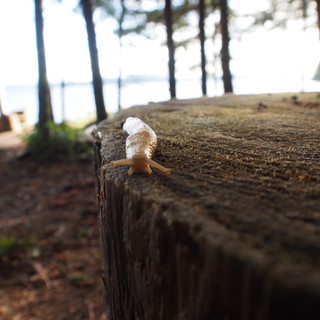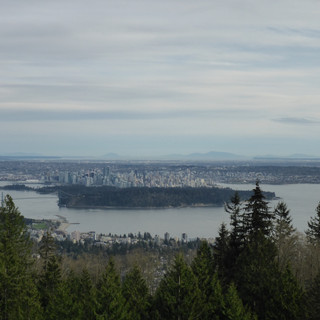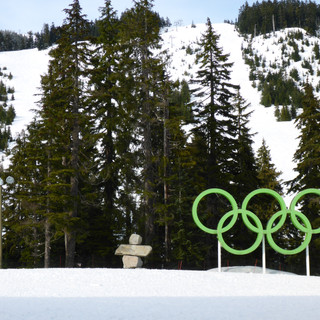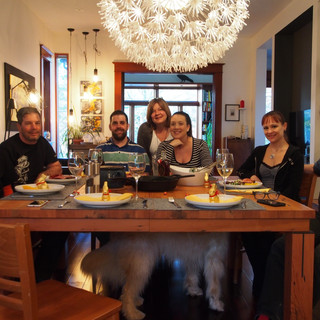March 22 to April 14, 2017 - Port Hardy to Vancouver (BC)
- linjen80
- 17 avr. 2017
- 11 min de lecture
After staying one more day in Port Hardy, due to the weather, we departed on Thursday, March 23 towards Port McNeill (but on the road this time). Several days of strong winds, up to gale force, were expected. Paddling would not have been possible and we wanted to move forward.
We followed Highway 19 all day. We progressed very well despite the hills. The pavement was wide enough not to feel too dangerous when cars and trucks passed. Then, as I helped to hold the canoe to avoid gaining too much speed on a downward slope, I made a bad move. Damn! My left knee no longer wanted to “play”. I could hardly move it. I felt like everything was going to tear inside. At times, my knee would not bear my weight, on other occasions, it simply did not want to bend. Nevertheless, we continued to walk in search of a place where we could set up camp to rest. During the last hour, I could not afford to stop because I simply could not start walking again. I limped badly. I was seriously hurt. We found a remote location in an old gravel pit. Once lying down, I felt no pain, but when I started to move, the pain intensified. That evening, I did several stretching exercises in the hope of helping the situation.
The next morning was encouraging. I had no more pain and it seemed to me that my mobility was almost completely back. It was a brief relief, because it didn’t take long before I started limping again. It became even worse than the day before. I could not walk more than 1 km/h. My knee no longer bent, and the pain, at times, was almost unbearable. We agreed that I should hitchhike to get to Port McNeill. Pierre and Jasmine would keep walking with the canoe. There were only 15 km left to reach the village. 45 minutes after starting our walk, we saw a sign showing the Cluxewe Resort and Campground. I remembered that this campground was right on the water's edge, so we left Hwy 19. We were glad to be back near the water. We both knew that now, long portages on the road, would be out of the question. I had a similar injury in the past and it took at least six months before I could resume normal activities.
Friday, March 24 was a great day of canoeing. It was sunny. It was so good to feel the heat of the sun on our faces. The brightness made us feel very motivated. The water remained calm almost all day, as we were well protected from the wind (except in a few places). The landscape was magnificent! At one point, across from Alert Bay, we could distinguish the snow-covered mountains on Vancouver Island through the fog and the clouds hanging at their summit. There were some rain showers in front of us, but the sun kept piercing through. At Telegraph Cove, the sun was shining brightly. The immense houses on the side of the hill overlooked the shallow turquoise waters of the shore.
It was also on that day that we began to play with the counter-currents created by the tide. Despite a contrary tide, we advanced very well because of the reverse current. Near our destination, we saw several wood platforms on the edge of the forest, located in the hollow of a beautiful small pebble beach. After gathering water from a stream, we returned just in time to the platforms, the wind and the waves rose all of a sudden. It was raining abundantly and we were starting to get cold. While Pierre was installing the tarp and I was emptying the canoe, a grain line (squall line) passed, wind blowing over 70 km/h! The waves passed over the canoe's deck! It only lasted 2 minutes, but it was intense.
At dinner, the mosquitoes appeared. These tiresome beasts were already trying to suck our blood. The mosquitoes were big. Pierre's explanation: "The mosquitoes do not die here during the winter. They wear snowshoes." :)
We remained at the same location until the morning of March 30. We could not paddle. Gale warnings, waves above six feet, torrential rain ... We spent a lot of time in the tent napping, writing and exchanging ideas on our next project. We also explored the forest; green, tall and majestic. The trees are big, but it was especially those who were lying on the ground that caught our attention. The biggest we saw was an estimated 16 feet in diameter. With its roots, it was nearly 20 feet wide! The ferns were also oversized. Jasmine could hide completely underneath them!
When we were finally able to start paddling, we knew we had to take advantage of the Johnstone Strait currents and the northeasterly wind. We sweated a lot that day in our dry suits. It was warm. We paddled without our gloves practically all day. In the early evening we arrived at Kelsey Bay. Just before we turned the last corner and arrived at the marina, we saw the Alaskan ferry. We had a great day with 60 km.
We were well received by Dan, owner of the Kelsey Bay RV Campground (http://stairway.org/kelseybayrvcampground/). The darkness quickly settled. We finished erecting the tent with our headlamps. We took advantage of a good hot shower before going to bed around 10:30pm.
The next day, under rain (which didn’t wanted to let go), we were looking for options to keep moving forward. We were expected at Abbotsford on April 12 and at Gibsons on April 6th. We could not walk the road (due to my knee). The weather forecast was not looking good, and we knew that the passage of Seymour Narrow was going to be difficult. We had to be well coordinated with the tides. This passage, in the Discovery Passage, is feared by several boaters. At its peak, currents can reach up to 15 knots (27.78 km/h). Captain George Vancouver described the passage as one of the most infamous in the world (before the Ripple Rock explosion). The Ripple Rock explosion (which was a mountain with two peaks located below the surface of the water at 9 feet deep at low tide in the Seymour Narrows) made the passage safer. 119 boats were sunk before the explosion and 114 people died. The explosion took place on April 5, 1958 after 27 months of work. The event was broadcast live on CBC television (from coast to coast). It was considered at that time the largest commercial and non-nuclear explosion in North America (https://www.youtube.com/watch?v=6W9PV_s_zF4).
While I was looking for solutions, Pierre came back running to tell me we had transportation to Brown's Bay Marina (located before Seymour Narrows). Dan, the owner of the campground, was willing to take us there. In less than 30 minutes, the entire camp was packed up and placed in the van.
Once in Brown’s Bay Marina, we looked for another transportation to get to Campbell River (and avoid the wait caused by the Seymour Narrows). Eddie, a very nice gentleman Pierre met who was filling his boat with diesel, offered us his help. What a beautiful encounter. Eddie took the scenic roads and gave us a wealth of information, then he proposed to take us to the Comox ferry. He knew we wanted to get there to catch the ferry and get to Powell River. We looked at each other and decided to accept his offer. The weather was not good for the next day, so we would have had to wait in Campbell River. When we arrived in Comox, we only had 20 minutes to get ready to board the boat, otherwise, we would have had to wait for the 7:00 p.m. ferry (a 4 hour wait). In a hurry and in the rain, we managed to put the wheels under the canoe, empty the truck and fill the canoe. We said thank you, and goodbye, to Eddie and left for a new adventure. We had no idea that morning when we woke up that so many solutions, and above all, so many generous people would show up at the right time to help us move on.
Once we were across the Georgia Strait, in Powell River, we walked to the campground. We found a site and set up our camp. Around 7:30 pm, we were in bed, but we could not sleep. The day had been too intense. It seemed like if we were in the TV show The Amazing Race!
We decided to stay one more night in Powell River so we could clean, wash and do our errands. We also felt more comfortable with the time frame we had left to get to Gibsons. On the morning of April 2, we prepared to leave. We knew that the winds would intensify during the day, but we also knew we would be protected. We had to leave before the waves and the wind became problematic. We met with several people that morning and took the time to talk. We had some very interesting discussions. While we were on the beach and ready to fill up the canoe, the wind and waves intensified. We could no longer leave! So, we figured we would wait and see if a window would show up and allow us at least to paddle to Saltery Bay. During our wait, we met Ryan, Julie and their boys Matthis and Gaël. Ryan offered to drive us to the other side of the ferry crossing (Saltery Bay - Earls Cove). They were going to visit Lund in the afternoon and on their way back, if we were still there, they would pick us up. That's what happened and we were pleased about it. Happy because we once again met and shared time with an incredible family. Another beautiful friendship was created. Julie is a teacher at the Ecole du Pacifique in Sechelt (French school). She invited us to give a presentation to her school on Wednesday. It was at Pender Harbour Marina that we left our new friends, but only for a few days.
From Pender Harbour (very nice countryside), we paddled to Secret Cove. Thanks to Donna from the Gibsons Paddle Club, Scott (marina manager) and the agreement owners, we were able to camp on a dock, hidden from the wind by a huge boat. The next day, the winds were still too strong to paddle to Sechelt. We had to find a solution to get there, as the presentation at the school was scheduled the next day. We met Morag and Pat, and their dog Daisy. A lovely, welcoming and really helpful couple. They took us to Sechelt twice, rather than once, and we slept at their home. We also went for a walk in Smuggle Cove all together. It was a great chance and a great pleasure to meet Morag and Pat.
On Wednesday April 5th, we had the pleasure of meeting with the teachers and students of the Pacific School. A great experience! We had not given a presentation in French for a long time. At the end of the day, we went for dinner with Julie and Ryan. The conversation was really interesting and profound. A beautiful evening! We were sorry to learn the next day that the whole family was now sick. Matthis had caught the virus first and was sick when we had met the family for the first time.
PThe next day, Donna and Ed, from the Gibsons Paddle Club, came to pick us up at Sechelt. After recovering the canoe, that had been left at Julie's and Ryan's, we left for Gibsons. The weather did not allow us to paddle and we had a presentation at the club that evening. Gibsons is a very pretty town. We were lucky enough to explore it in the afternoon. We also saw the famous Molly's Reach restaurant (http://mollysreach.ca/about/) made popular from the TV series Beachcombers.
There is a lot of history in the Gibsons Paddle Club and above all a soul that manifests itself by each member's actions and words. We were lucky enough to receive a special gift. Ed took the time to explain the story behind the club, its values and the importance of First Nations. We received, from Pat and Ed, a necklace that each of the club members receive one day. This necklace is a powerful symbol. The centre is made from the wood of Devil's Club. This Pacific coast plant is very important in First Nations culture and medicine. Harvested in a respectful way according to tradition, a piece is cut and placed between four wooden beads (two on each side) representing all colours of the human race. The assembly represents fraternity among nations, the spirit of First Nations and respect for water. Pat and Ed were very emotional at the handing over of the necklaces. Jasmine also received one! We had a lovely evening with the whole group. Then, Kathy and Phil invited us to stay at their home. What a wonderful and caring couple. We had a great time with them, and again, we were pleased to have deep and enriching discussions.
On Friday morning, we went out with the club outriggers. These canoes were manufactured by Clipper Canoes. A pure pleasure to paddle! We were very grateful for the opportunity and the fact that the group decided to paddle despite the conditions. In the afternoon, we went to Ed and Joy's home. Ed is an accomplished artist and his works are magnificent. I could have spent hours and hours losing myself in his paintings. His technique is very interesting and I love his style. Go to his website to see his works: http://edhillart.com/.
In the evening, we were invited to Noelline and André's, a couple from Quebec who moved to British Columbia many many years ago. Noelline is also a teacher at the Ecole du Pacifique in Sechelt and is a colleague of Julie. What a delicious supper and, above all, what a pleasure we had! It was funny to feel ourselves among friends in Quebec, while we were here on the Pacific coast.
On Saturday morning, Kathy had already planned a big breakfast for my birthday. What beautiful attention! She had even prepared a birthday cake for the evening (as we left Gibsons in the morning) with candles and matches. Kathy is a very caring person and she has a huge heart.
On Saturday, we still could not paddle. Before leaving Gibson's, the members of the club (that we met on Thursday night) came to say goodbye and to give us gifts. We felt spoiled and greatly welcomed. Ed and Joy took us to the ferry. Donna was with us also, before our departure.
On the ferry toward North Vancouver, we told ourselves how much we have been well received by all the wonderful people we had the chance to meet. The Sunshine Coast has been a very special leg of our journey for us.
A new chapter began once we arrived in Vancouver, as Danielle, Pierre's sister, came to pick us up. Pierre and Danielle had not seen each other for years, even decades! And it was the first time I met my sister-in-law! It was a beautiful reunion and a very warm welcome. I will never forget my 2017 birthday. I received a lot of love and affection. Witmar (Danielle's spouse), Vanessa (her daughter), Jason (her son-in-law) and Jackie (friend and neighbour) were all present for our welcome dinner. In addition, Jasmine met her cousin, Cooper. We had a great weekend with the family. What a joy to finally be all together.
On Monday, we took the canoe to Western Canoeing and Kayaking. It was the return to our canoe’s birthplace. We were very happy to finally meet Lynne, Marlin and Mary, people of heart and passion. They welcomed us as family members. We had a tour of the facilities and the manufacturing plant (Clipper Canoes). We did an interview on CBC Radio on Tuesday morning. Wednesday was a very busy day. After carpooling with Witmar, Danielle, Jackie and our dogs (5 people and three dogs in the same car), we went to North Water where we met Morgan. It was nice to see the facilities and projects going on. North Water is the company that created the spraydeck for the canoe. Then, we went back to Western Canoeing and Kayaking in Abbotsford.
Mary invited us to try the Clipper Sea-1, a solo expedition canoe. We loved our experience, the speed of the canoe, its maneuverability and its volume. A true solo expedition canoe. A pleasure to paddle. Even Jasmine approved! Then, in the early evening, we gave a presentation. We would like to thank all of the people who came to see us and to say a big thank you for the donations. Thanks again to Lynne, Marlin and Mary for everything. Thank you for the opportunity, your trust, your generosity, your welcome, the incredible work done on the canoe and the magnificent evening.
We are still with Danielle and Witmar at this time. We are being pampered. What a joy to be all together! Yesterday we went to visit Squamish and Cypress Mountain. The view from Cypress is amazing! We are now planning the next leg of our journey. We will leave soon, and this time, it is the crossing of Canada that awaits us.



















































































































































































































Commentaires